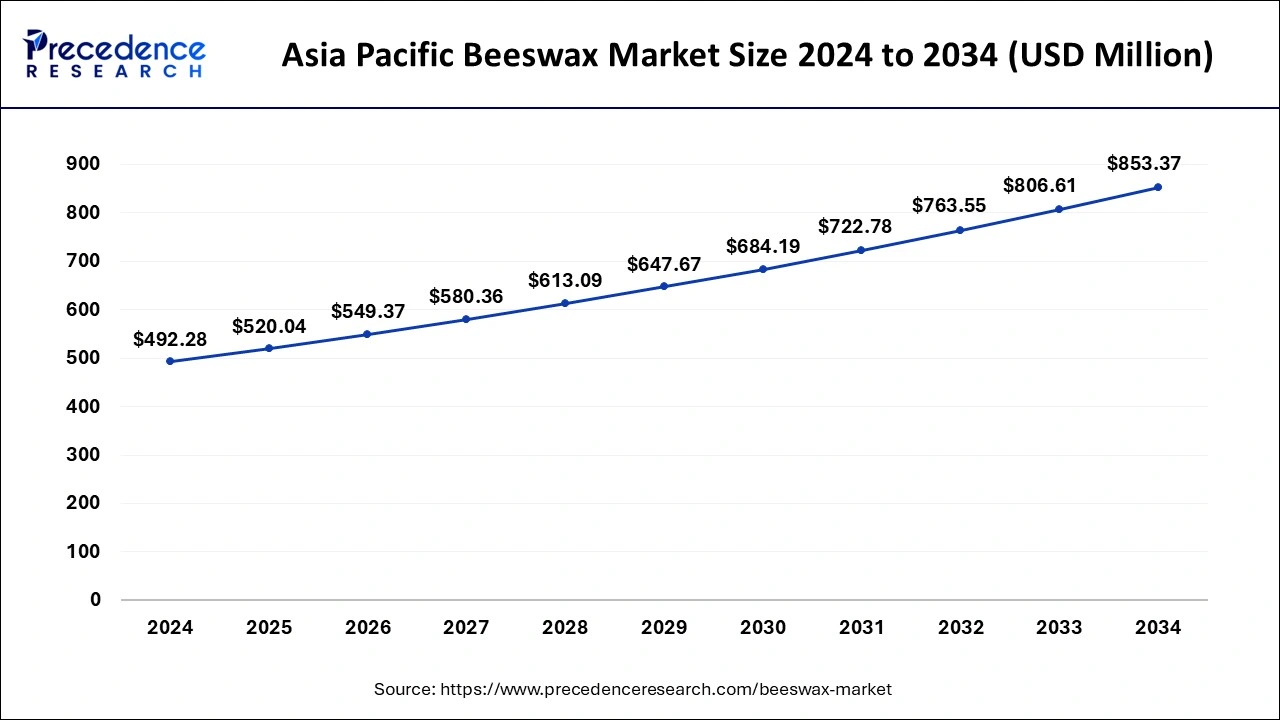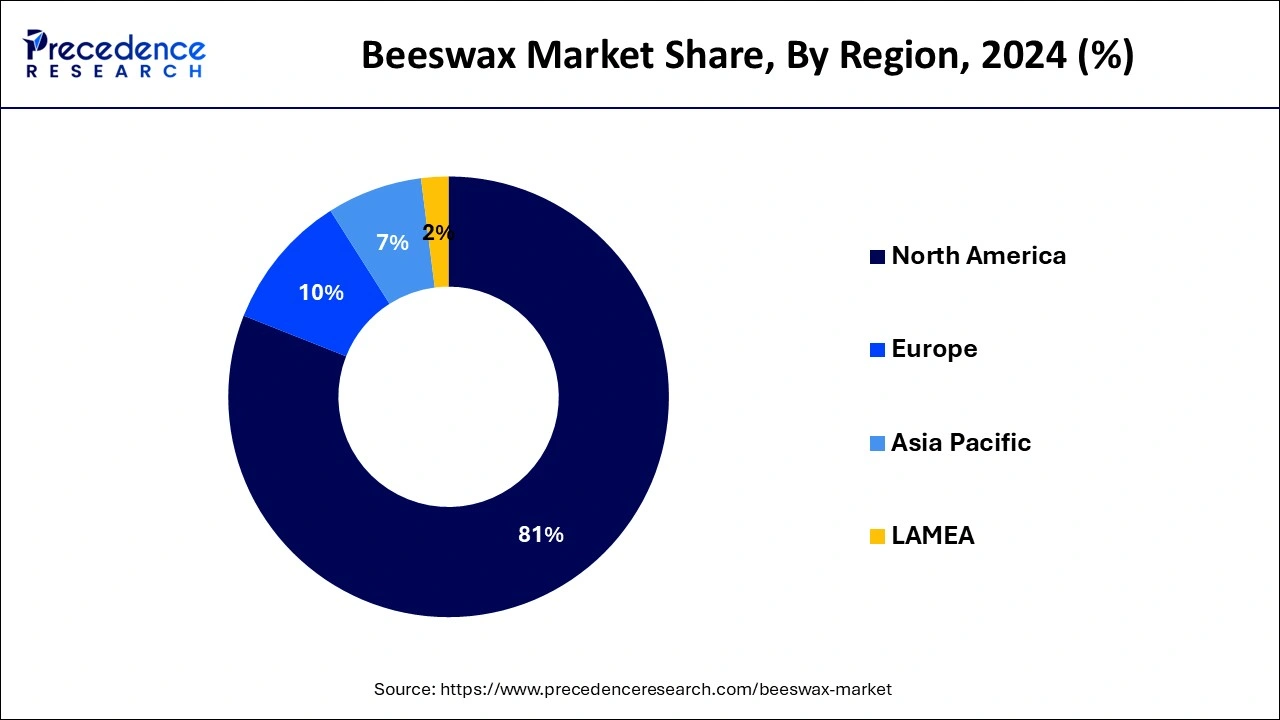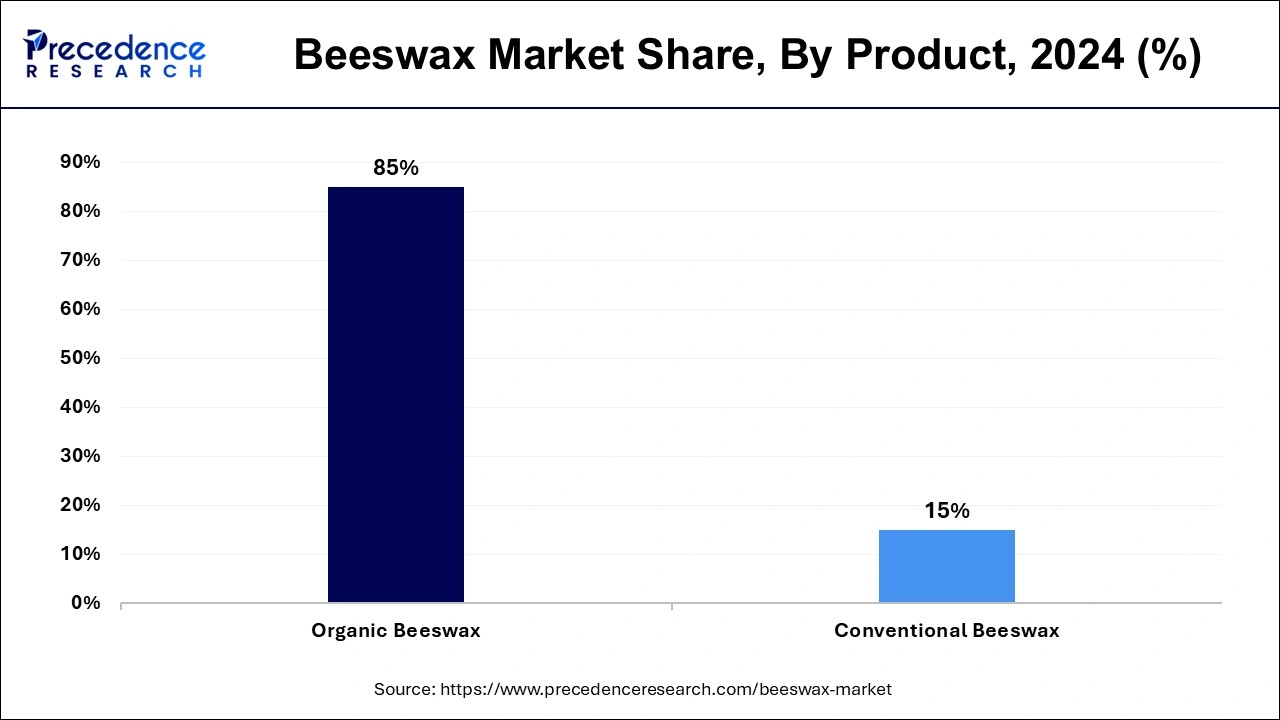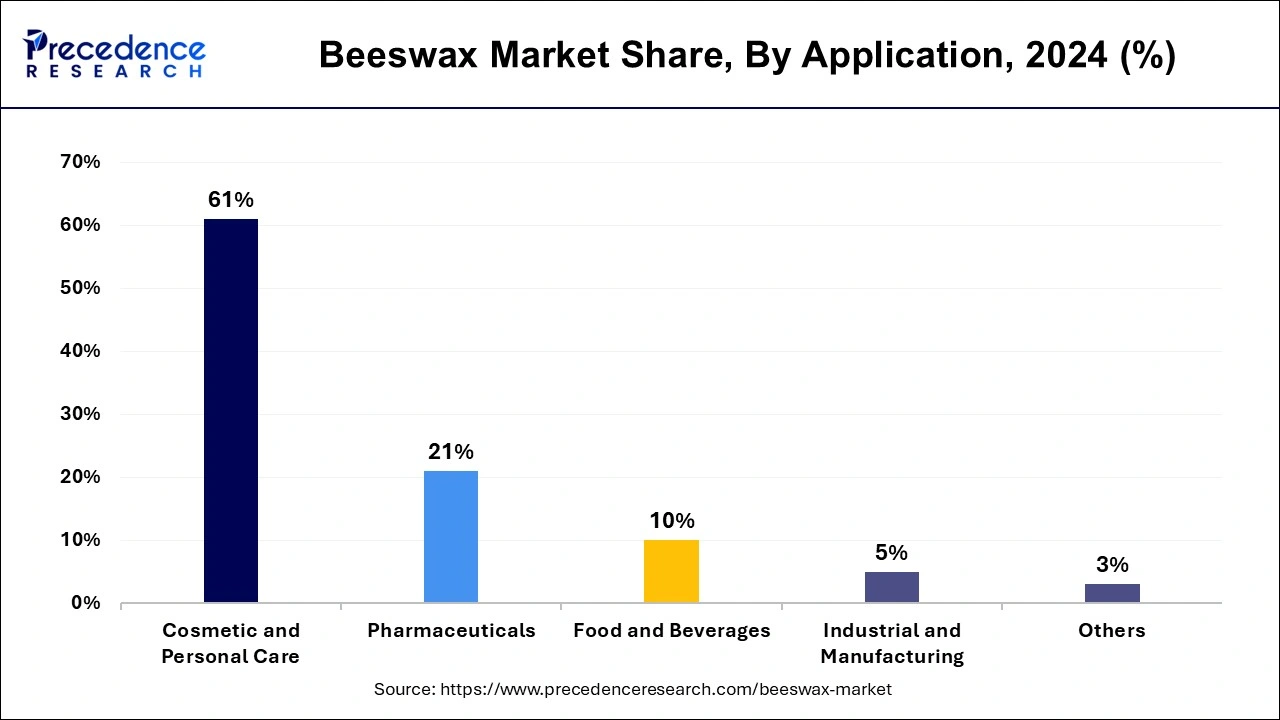The global beeswax market size is calculated at USD 642.02 million in 2025 and is forecasted to reach around USD 1047.08 million by 2034, accelerating at a CAGR of 5.59% from 2025 to 2034. The Asia Pacific beeswax market size surpassed USD 520.04 million in 2025 and is expanding at a CAGR of 5.66% during the forecast period. The market sizing and forecasts are revenue-based (USD Million/Billion), with 2024 as the base year.
The global beeswax market size was estimated at USD 607.75 million in 2024 and is predicted to increase from USD 642.02 million in 2025 to approximately USD 1047.08 million by 2034, expanding at a CAGR of 5.59% from 2025 to 2034. Beeswax is a great plastic alternative, easy to use because it has no harmful chemicals, is free from toxins, and has antibacterial and anti-inflammatory properties, which lead to high demand in various industries and contribute to the market's growth.

The Asia Pacific beeswax market size reached USD 492.28 million in 2024 and is expected to be worth around USD 853.37 million by 2034 at a CAGR of 5.66% from 2025 to 2034.

Asia Pacific dominated the beeswax market in 2024. Beeswax is a natural ingredient, and it plays an important role in various industries and high demand in the Asia Pacific region. China is a dominant country in the Asia Pacific region in terms of the production of beeswax, and it has a long beekeeping history. China has a suitable climate and large agricultural land that provides plenty of opportunities for beekeepers. Regions like Shanxi, Sichuan, and Yunnan are well-known for their high-scale production of beeswax. India is also a significant country in the Asia Pacific region for the production of beeswax. India’s suitable environmental conditions and large honeybee population contribute to the growth of the beekeeping industry. States such as Maharashtra, Punjab, and Uttar Pradesh are well-known for their considerable production of beeswax. Beeswax of India is particularly valued due to its purity and quality. These factors help to the growth of the market in the Asia Pacific region.

Beeswax is a natural wax product extracted from the honeycomb cells of honeybees of the genus Apis. The beeswax market deals with the production and marketing of eco-friendly and natural products. The production of beeswax-based products is done in many industries, such as pharmaceuticals, foods, and cosmetics. The properties of beeswax are it does not contain harmful chemicals and is easy to work. Beeswax is free from toxins and is natural, water-repellent, antibacterial, and anti-inflammatory.
These properties of beeswax help in the production of outstanding skin care products and contribute to the growth of the market. It may be used instead of synthetic ingredients and plastics due to waste. The beeswax may also be used to replace various household things like candles, furniture polish, cling wraps, and packaging. In personal care products like hair care, nail care, face creams, lipsticks, and lip balms, beeswax are used. Beeswax is used for fire lighters and earplugs. These applications help to the growth of the market.
| Report Coverage | Details |
| Growth Rate from 2025 to 2034 | CAGR of 5.59% |
| Market Size in 2025 | USD 642.02 Million |
| Market Size by 2034 | USD 1047.08 Million |
| Largest Market | Asia Pacific |
| Base Year | 2024 |
| Forecast Period | 2025 to 2034 |
| Segments Covered | By Product Type, By Application Type, and By Distribution Channel |
| Regions Covered | North America, Europe, Asia-Pacific, Latin America, and Middle East & Africa |
Rising demand in various industrial sectors
Rising demand for organic products leads to high demand for beeswax in various industrial sectors like waterproofed textiles, industrial lubricants, wood and leather finishes, candle manufacturing, metal casting molding, agriculture, food, pharmaceuticals, cosmetic and personal care. Beeswax has a high demand for personal care products and cosmetics products, natural alternatives for plastics, petroleum wax, synthetic wax, food preservatives, and candles. It is used in cosmetic products due to its emulsifier properties, which may hold oil and water-based ingredients together.
To retain skin moisture, beeswax is used as a moisturizer in personal care products, soaps, hair products, lip balms, etc. It is also used as a food preservative because it prevents food spoilage and keeps food fresh. Beeswax has sustainable and renewable resources that have a positive effect on the environment. Beeswax is a long-lasting and durable substance that has been used in polishes, candles, and other products for a long time. These factors contribute to the growth of the beeswax market.
Side effects of the beeswax
The natural substance beeswax is used in many products like ointments, cosmetics, and candles. However, beeswax can cause some side effects, such as inadequate evidence, intestinal blockage, and skin reactions. During the treatment of various conditions, inadequate evidence may occur, like diaper rash, burns, anal fissures, ringworm, oral mucositis, and oral hemorrhoids. If beeswax is swallowed, it may be poisonous or harmful and cause intestinal blockage. This can also cause vomiting, nausea, and abdominal pain. Beeswax may cause allergies or skin reactions like burning, rashes, itching, redness, and swelling. If anyone uses beeswax products for skincare, it is important to remove beeswax products for skin breath. If not, then pores will block. These side effects of beeswax may restrict the growth of the beeswax market.
Expansion of beeswax production through apiculture and agriculture together
Beeswax can play a vital role in agriculture. Agriculture and apiculture offer significant opportunities to earn money through beekeeping. It helps to increase sustaining ecosystem services and crop productivity. Honeybees are important pollinators for different crops. Additionally, it also provides beneficial products such as beeswax, honey, royal jelly, propolis, pollen, and nectar. Also, it can increase the use of modern techniques in agriculture and apiculture for the collection of honey and beeswax. By the use of modern techniques, organized honey collections may provide an extra 10000 tons of beeswax and 120000 tons of honey from the forests. This technique can be applied to agriculture and apiculture to increase the production of beeswax. This contributes to the growth of the beeswax market.
The organic beeswax segment dominated the beeswax market in 2024. Organic beeswax does not contain any artificial or chemical agricultural substances like fungicides, insecticides, and herbicides. For our well-being, it is important to reduce exposure to numerous harmful chemicals. It is important to use organic beeswax for spills; blocks and bits are attainable for creating your creams and ointments that are free from artificial or chemical agricultural substances, including fungicides, insecticides, and herbicides, which leads to the continuous growth of the organic beeswax without harm to the earth.

In aromatherapy, organic beeswax is used due to its long-lasting burn time and smokeless properties. Beeswax spills are assumed to have an aroma of honey that is spicy, salty, strong, bloomy, fresh, and sugary. They are also used for the removal of floating contaminants like scents, allergens, dirt, and microbes. These are for promoting psychological and corporeal health by freshening the body with increasing energy, controlling blood pressure, reducing body pain, improving focus, and decreasing stress.
This use of organic beeswax helps to the growth of the market. Organic beeswax is also used in cosmetics like eye cosmetics, conditioners, and lip goods. Beeswax helps the skin with hydration and calmness. It is also used in hair care products for shiny hairs that increase smoothness and hair gloss. Organic beeswax has anti-viral and anti-inflammatory properties to stop damaging bacteria. These factors are helpful for the growth of the segment.
The cosmetics and personal care segment dominated the beeswax market in 2024. Beeswax is a high-demand ingredient in various cosmetics and personal care products because of the number of advantages it has for hair and skin. Beeswax is the key factor in the products. The products that use unprocessed and pure beeswax will benefit your hair and skin significantly. Processed or synthetic beeswax can contain dangerous chemicals and not give the benefits of pure beeswax.
For the effectiveness and quality of beeswax, it is important to consider additional ingredients used in cosmetics and personal care products while choosing products. Beeswax contains several helpful properties for skin care, including a protective barrier, antimicrobial properties, and antibacterial and emollient properties. When beeswax is applied to the skin, it forms a protective barrier to prevent drying and to keep the skin moistened. Beeswax's antimicrobial properties are helpful for protecting skin from harmful fungi and bacteria.

The pharmaceutical segment is the fastest-growing during the forecast period. Beeswax has several applications in the pharmaceutical sector. Beeswax is used as the shell and coatings of some pills and tablets. Beeswax is used in creams and ointments as a stiffening agent. It helps in maintaining the texture and consistency of the formulations. Beeswax allows the incorporation of the water in oil emulsions. This is the main property for creating stable formulations of oil-soluble and water-soluble together. In the pharmaceutical industry, pharmaceutical-grade beeswax acts as a base material for ointments. Beeswax is used in the production of Chinese patent medicine encapsulation.
It is used in the formulation due to it plays a role as a slow-release agent. Beeswax may be used in the manufacturing of dental casting wax, like sticky wax and base wax for tooth models. Nowadays, the implantation of electronic instruments in the body of human beeswax containing rubber film is used. These advantages are helpful for the growth of the pharmaceutical segment and the growth of the beeswax market.
The indirect distribution channel type segment dominated the beeswax market in 2024. Beeswax is provided to the consumer indirectly through various businesses. The bulk amount of beeswax is distributed to businesses, including food production, pharmaceuticals, cosmetics, soap making, candle making, and personal care products for several formulations. Various essential products we use daily are made from beeswax, which comes indirectly from the different products.
By Product Type
By Application Type
By Distribution Channel
By Geography
For inquiries regarding discounts, bulk purchases, or customization requests, please contact us at sales@precedenceresearch.com
No cookie-cutter, only authentic analysis – take the 1st step to become a Precedence Research client